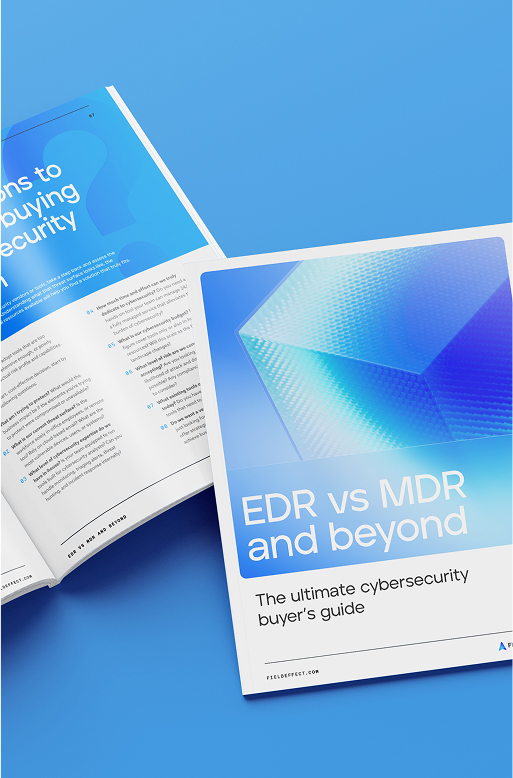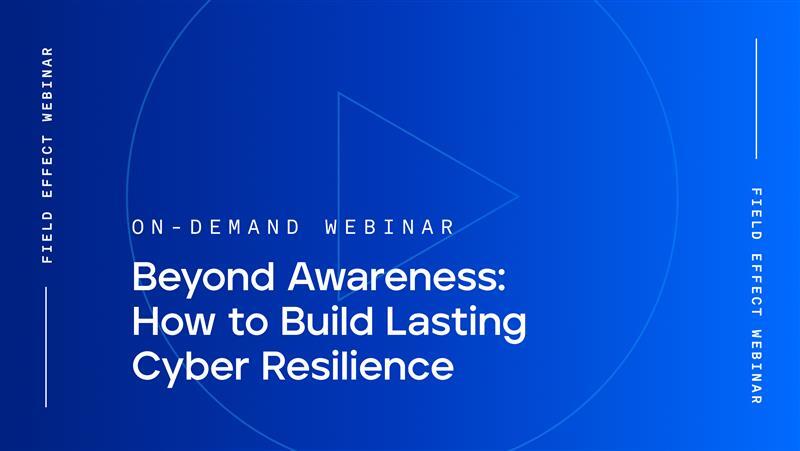
Blog Post
Last updated: November 13, 2025
The ever-expanding cybersecurity market offers many solutions, including:
And that's just the beginning. Navigating these options can feel overwhelming, but it's something that every business will have to do. Implementing the right security solutions for your organization is essential for protecting your digital assets and having peace of mind.

EDR vs MDR and beyond
Make sure you're making a smart buying decision with this ultimate guide.
You'll learn how EDR and MDR compare, plus strategic questions to vet vendors and their solutions.
For many years, endpoint detection and response (EDR) tools have been the go-to cybersecurity solution. It's no surprise why. EDR tools provide visibility into threats happening on endpoints and allow for quick detection and response.
While there's no denying that EDR tools have their fair share of benefits, relying solely on them to protect your valuable IT assets can leave significant portions of your threat surface at risk. EDR solutions are just one piece of a much larger cybersecurity landscape, and holistic coverage is a must for effective cybersecurity.
EDR tools continuously monitor and analyze endpoint activities in an organization's network. They detect, assess, and respond to potential security threats like malware or other malicious activities.
EDR tools collect data from endpoints, and use advanced analytics to identify suspicious behavior. If the system detects a threat, it takes predefined actions to contain it. For example, the EDR tool may isolate an infected endpoint for security teams to investigate further.
While EDR tools are not the comprehensive cybersecurity solution that most businesses need to properly protect against today's wide range of attack tactics and techniques, it's still important to acknowledge their significant role in cyber defense.
Businesses used to rely heavily on antivirus software to protect against cyber threats. While antivirus technology can defend against known threats using signature-based detection, it falls short when faced with new, unknown threats. That's where EDR solutions prove their worth.
EDR tools have outpaced their antivirus predecessors thanks to heuristic analysis, a method that goes above and beyond signature-based detection. Instead of just matching signatures, EDR tools analyze behavior patterns to detect threat actors earlier in their attack and quarantine threats before they can cause significant damage. For instance, an EDR tool might flag repeated failed login attempts or sudden, unusual data transfers as indicators of a potential cybersecurity incident.
EDR solutions enable quicker, more accurate threat detection, reducing the possible impact on business operations. They can provide visibility into stealthy threats that slip by antivirus defenses.
Another benefit of EDR solutions is that they cover endpoints, which comprise a huge portion of any organization's threat surface.
Even for relatively small businesses, endpoints can quickly scale into hundreds or thousands when you account for employee laptops, phones, and tablets. These endpoints are a major target for threat actors seeking access to an organization's networks and data.
EDR monitors and fortifies these vulnerable entry points by providing visibility and control over a massive chunk of the potential attack surface. This protection goes a long way in limiting risk.
With the ever-increasing complexity and volume of attacks, quickly identifying and neutralizing threats at the endpoint level has become essential. EDR tools continuously monitor and collect data on endpoint activities, including file execution, network communications, and system modifications. This visibility allows the detection system to recognize deviations from baseline behaviors that may indicate a cyber threat.
Suppose an employee's computer starts to behave unusually, such as executing files overnight or connecting to a suspicious overseas server. The EDR system immediately flags it as a potential threat. This continuous, automatic tracking of endpoint activities helps identify and block potential threats before they can cause more significant damage to the system.
Once the system detects a threat, sophisticated EDR tools can remedy the situation quickly. Response activities may include isolating the affected endpoint, denying network access to a malicious IP address, or even rolling back the endpoint to a previous state to undo the changes made by an attacker. This swift response helps protect users from further damage.
While EDR has some compelling strengths compared to traditional antivirus and signature-based protections, it also has some major weak points.
Relying solely on EDR leaves dangerous gaps in network visibility and protection. Here are a few key reasons why EDR alone can't fully protect modern organizations from advanced cyberattacks.
EDR solutions typically adopt a reactive approach to cybersecurity. They focus on detecting attacks as they happen, rather than preventing them in the first place. And while detecting and responding to an incident quickly is crucial, so is proactive threat hunting and risk management.
Here's why.
Let's consider ransomware, one of the prevalent threats facing businesses today. When dealing with a ransomware incident, being reactive might mean the EDR sounds the alarm once the ransomware is deployed and the files are encrypted.
A proactive approach would involve minimizing risk, so the threat actor has a harder time to infiltrate systems to begin with. It may also involve detecting and addressing suspicious behavior earlier in the attack chain, before the threat actor has a chance to deploy the ransomware.
Unfortunately, these are beyond the scope of traditional EDR solutions.
As cybersecurity threats evolve, businesses need more security than an EDR tool offers. The partial coverage provided by EDR tools creates blind spots in an organization's security posture, leaving critical portions of IT infrastructure unprotected.
These blind spots in network traffic, cloud services, and the Internet of Things (IoT) become vulnerable to breaches and cyberattacks. With the increasing adoption of the cloud and IoT in many operations, these areas present essential access points for malicious actors. A compromised cloud account, for example, could allow the threat actor to access and leak sensitive company data found in emails. As long as no activity is happening on the endpoint, the threat actor would get off undetected.
Knowing that many organizations have EDR tools in place, threat actors are finding their way into systems in new ways. Their tactics bypass endpoint detection, exploiting the gaps left unaddressed by EDR solutions. Without this visibility, organizations will struggle to determine if and how an attacker has accessed their system.
Another challenge with EDR tools is that their endpoint-only visibility results in more false positive alerts.
More holistic platforms can apply context and correlate events across endpoints, networks, and cloud services for more accurate threat alerting. But EDR tools have limited visibility and, as a result, often flag normal user or admin actions on endpoints as potential threats simply because they broadly match heuristic profiles for "suspicious activity."
Without complete context, EDR alerts make it extremely difficult to pinpoint actual incidents versus false alarms. With such noise, security teams waste valuable time chasing false alarms while real threats slip through cracks in visibility.
Excessive false positives make it harder to identify real threats promptly. Over time, it can also lead to alert fatigue, potentially leading analysts to ignore alerts or disable EDR agents altogether—putting organizations at heightened cyber risk.
An often-overlooked limitation of EDR solutions is the level of expertise required to effectively deploy, tune, and manage them. EDR solutions are not set-it-and-forget-it tools; they need a person on the other end with vast knowledge of cybersecurity concepts, the threat landscape, and evolving hacker methodologies. That person also needs a deep knowledge of the EDR tool itself.
EDR tools can't run on their own, they need to be managed. Typically, this would look like a team of cybersecurity professionals to deploy the tool, configure it precisely, and understand and interpret the alerts. And most importantly, it's this team that responds rapidly when the system detects the threat.
Maintaining a dedicated cybersecurity team to handle EDR systems is difficult for small and mid-sized businesses, primarily due to cost. The growing shortage of skilled cybersecurity professionals only adds to the challenge. In the U.S., there is a severe shortage of cybersecurity professionals, resulting in over 700,000 cybersecurity positions remaining unfilled.
Managed service providers (MSPs) are the trusted cybersecurity vendors. However, they grapple with unique challenges while managing client environments that go beyond the limitations imposed by standard EDR solutions.
MSPs that deploy and oversee an EDR solution for hundreds, sometimes even thousands, of customers may find it quickly becomes unmanageable. EDR solutions are notoriously hard to manage and tune—even more so for businesses that don’t have the time, effort, or expertise.
Layering security tools, such as NDR or SIEM, for comprehensive coverage adds complexity and costs—not to mention the additional resources needed to oversee these tools.
EDR gives MSPs more insight into what’s happening on their clients’ endpoints, allowing them to resolve threats quickly. However, this narrow focus on endpoint telemetry negatively influences threat detection. Abnormal endpoint activity paints an incomplete picture.
MSPs often add more tools to cover other components of the threat surface, but with each tool producing its own alerts, staff can overwhelm quickly.
To provide an effective cybersecurity solution, MSPs must move beyond EDR tools and adopt a holistic approach.
While EDR solutions are a step up from traditional antivirus and legacy protections, they have major blind spots across networks, cloud environments, and IoT. They can't ensure comprehensive cybersecurity, and relying solely on EDR leaves dangerous gaps in your cyber defense that attackers may exploit.
To ensure business continuity, modern businesses need total visibility and control across the entire digital attack surface and capabilities to prevent and respond to threats. That's where Field Effect comes in. Field Effect MDR offers the holistic protection you need. It goes beyond EDR's capabilities with end-to-end protection for your entire IT infrastructure, providing 24/7 monitoring and threat hunting, accurate alerts, vulnerability identification, and a professional team to manage everything.
Remember, the foundation of robust cybersecurity lies in a well-rounded, comprehensive strategy that caters to all possible threat avenues. Don't settle for half-measures. Contact us today to experience Field Effect MDR's unparalleled visibility, protection, and support.


